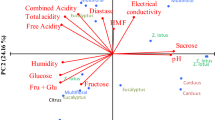Abstract
The present work describes a method for the determination of methyl anthranilate (MA) in honey, and reports the results of a study carried out on 46 Citrus honey samples produced in different countries. The MA content was measured, and the compliance of the samples with the unifloral Citrus honey profile was verified, according to the traditional authenticity parameters (physicochemical, sensory and microscopic). The analytical results show that MA values do not significantly differ in unifloral and not unifloral samples. More generally, no relationship could be found between MA content and the level of uniflorality or any single authenticity parameter. The conclusion is that MA content can not be used as a discriminating parameter for Citrus honey, and should be used only as a further descriptive element. Among the unifloral samples the MA content was lower in those produced in Italy than in the other countries, and mostly below the 2 mg/kg limit that some European laboratories require to accept Citrus honey.
Zusammenfassung
Ein Charakteristikum von Zitrushonig ist die Anwesenheit von Methylanthranilat (MA), von manchen Autoren wurde diese flüchtige Komponente als chemischer Marker für die Authentizität dieses Honigtyps vorgeschlagen. Die vorliegende Arbeit beschreibt eine ausgearbeitete Analyse zur Bestimmung von MA, die auf der Verwendung eines HPLC-PDA Systems nach einer sauren Extraktion und Reinigung mittels einer Copolymercartridge beruht. Wir berichten die Ergebnisse einer Studie, bei der 46 Zitrushonige aus verschiedenen Ländern untersucht wurden. Diese Proben wurden auf ihren Gehalt an MA und ihre Übereinstimmung mit dem Honigprofil von Zitrussortenhonig entsprechend der überkommenen Parameter (Sensorik, Pollenzusammensetzung und physiochemische Eigenschaften) untersucht. Die Übereinstimmung mit dem Sortenprofil wurde zu einer übergreifenden Ja/Nein Bewertung zusammengefasst.
Die Ergebnisse (Tab. IV) zeigten keinen signifikanten Unterschied des MA-Gehaltes zwischen den „Ja“ Proben (0,65 bis 2,86 mg/kg) und den „Nein“ Proben (0,18 bis 2,93 mg/kg), und es wurde keine Korrelation zwischen dem MA-Gehalt und irgendeinem der einzelnen analytischen Parameter gefunden. Dagegen wurde ein signifikanter Unterschied zwischen den in Italien und den in den anderen Ländern produzierten Honigen gefunden (Abb. 3), wobei die italienischen „Ja“ Proben geringere MA-Werte zeigten als die anderen Proben (im Mittel 1,56 mg/kg ± 0,60 gegenüber 2,63 ± 0,23 mg/kg). Einige Honigkontrolllabors verlangen einen Mindestgehalt an MA von 2 mg/kg, um einen Zitrus-honig als sortenrein anzuerkennen. Wenn man diese Unterscheidungsgrenze zu Grunde legt, würden nur 56,5 % der untersuchten Proben übereinstimmend mit der traditionellen Einordnung klassifiziert, mit 6,5 % fälschlich positiven und 37 % fälschlich negativen Ergebnissen.
Wir schließen daraus, dass MA als chemische Bestimmung der Sortenreinheit von Zitrushonig nicht geeignet ist, sondern nur als zusätzliches beschreibendes Element herangezogen werden kann, um zusammen mit den anderen Kriterien das analytische Bild dieses Honigtyps zu komplettieren.
Für italienische Zitrushonige könnte ein Minimalgehalt von 0,5 mg/kg gefordert werden, oberhalb dieser Grenze besteht allerdings kein Zusammenhang zwischen Sortenreinheit und dem Gehalt an MA. Der Grund für das unterschiedliche Verhalten der italienischen Zitrushonige sollte weiter untersucht werden, da dieses im Kontext internationaler Vermarktung bedeutsam ist.
Similar content being viewed by others
References
Aubert S., Gönnet M. (1983) Mesure de la couleur des miels, Apidologie 14, 105–118.
Bogdanov S., Martin P., Lüllmann C. (1997a) Harmonised methods of the European Honey Commission. Determination of electrical conductivity, Apidologie, extra issue, 14–16.
Bogdanov S., Martin P., Lüllmann C. (1997b) Harmonised methods of the European Honey Commission. Determination of hydroxymethylfurfural by HPLC, Apidologie, extra issue, 23–24.
Cabrera Ruiz C., Montilla J., Gomez E., Hernandez G., Molins Marin J.L. (1997) Analyse physicochimique des miels d’oranger commercialisés en Espagne, Bull. Tech. Apic. 24, 63–70.
Crane E., Walker P., Day R. (1984) Directory of important world honey sources, IBRA, London.
Deshusses J., Gabbai A. (1962) Recherche de l’anthranilate de méthyle dans les miels espagnols de fleur d’oranger par Chromatographie sur couche mince, Mitt. Lebensm. Unters. Hyg. 53, 408–411.
Ferreres F., Giner J.M., Tomás-Barberán F.A. (1994) A comparative study of hesperetin and methyl anthranilate as markers of the floral origin of Citrus honey, J. Sci. Food Agric. 65, 371–372.
Lothrop R.E. (1932) Specific test for orange honey, Ind. Eng. Chem. Anal. Ed. 4, 395.
Mateo R., Bosch-Reig F. (1998) Classification of Spanish unifloral honeys by discriminant analysis of electrical conductivity, color, water content, sugars and pH, J. Agric. Food Chem. 46, 393–400.
Nelson E.K. (1930) The flavor of orange honey, Ind. Eng. Chem. 22, 448.
Nozal M.J., Bernal J.L., Toribio L., Jimenez J.J., Martin M.T. (2001) High-performance liquid Chromatographic determination of methyl anthranilate, hydroxymethylfurfural and related compounds in honey, J. Chromatogr. A 917, 95–103.
Peris J. (1981) Types of Spanish honeys. I. The Citrus honey of Valencia zone, 28th Apimondia Int. Congress, Acapulco, pp. 456–457.
Persano Oddo L., Piro R. (2004) Main European unifloral honeys: descriptive sheets, Apidologie 35 Suppl. 1, S38-S81.
Persano Oddo L., Piazza M.G., Sabatini A.G., Accorti M. (1995) Characterization of unifloral honeys, Apidologie 26, 453–465.
Serra Bonvehí J. (1988) Determination de antranilato de metilo en la miel de citricos (Citrus sp.) del Levante Español, y su influencia en la actividad diastasica de la miel, Alimentaria 197, 37–40.
Serra Bonvehí J., Ventura Coll F. (1995) Characterization of Citrus honey (Citrus spp.) produced in Spain, J. Agric. Food Chem. 43, 2053–2057.
Serra Bonvehí J., Gómez Pajuelo A., Gonell Galindo J. (1987) Composición, propriedades fisicoquímicas y espectro polínico de algunas mieles monoflorales de España, Alimentaria XXIV (185), 61–84.
Von der Ohe W., Persano-Oddo L., Piana L., Morlot M., Martin P. (2004) Harmonised methods of melissopalynology, Apidologie 35 Suppl. 1, S18-S25.
White J.W. (1966) Methyl anthranilate content of Citrus honey, J. Food Sci. 31, 102–104.
White J.W., Bryant V.M. (1996) Assessing Citrus honey quality: pollen and methyl anthranilate content, J. Agric. Food Chem. 44, 3423–3425.
Author information
Authors and Affiliations
Corresponding author
Additional information
Manuscript editor: Stefan Fuchs
Rights and permissions
About this article
Cite this article
Sesta, G., Piana, M.L., Persano Oddo, L. et al. Methyl anthranilate in Citrus honey. Analytical method and suitability as a chemical marker. Apidologie 39, 334–342 (2008). https://doi.org/10.1051/apido:2008009
Received:
Revised:
Accepted:
Issue Date:
DOI: https://doi.org/10.1051/apido:2008009




